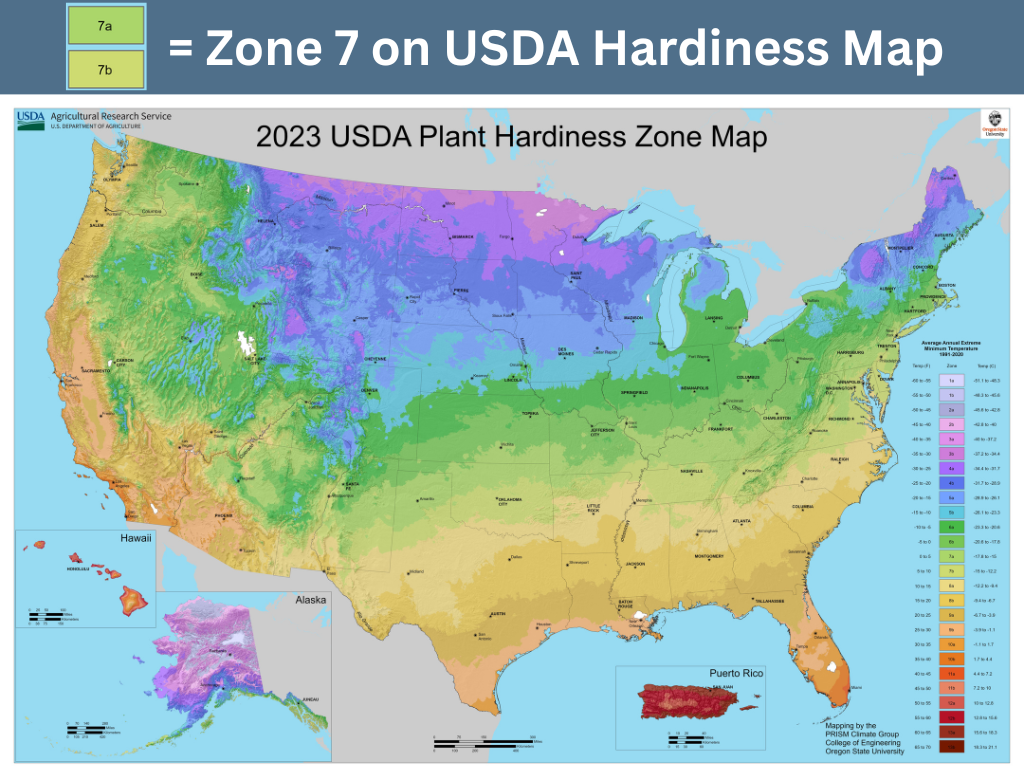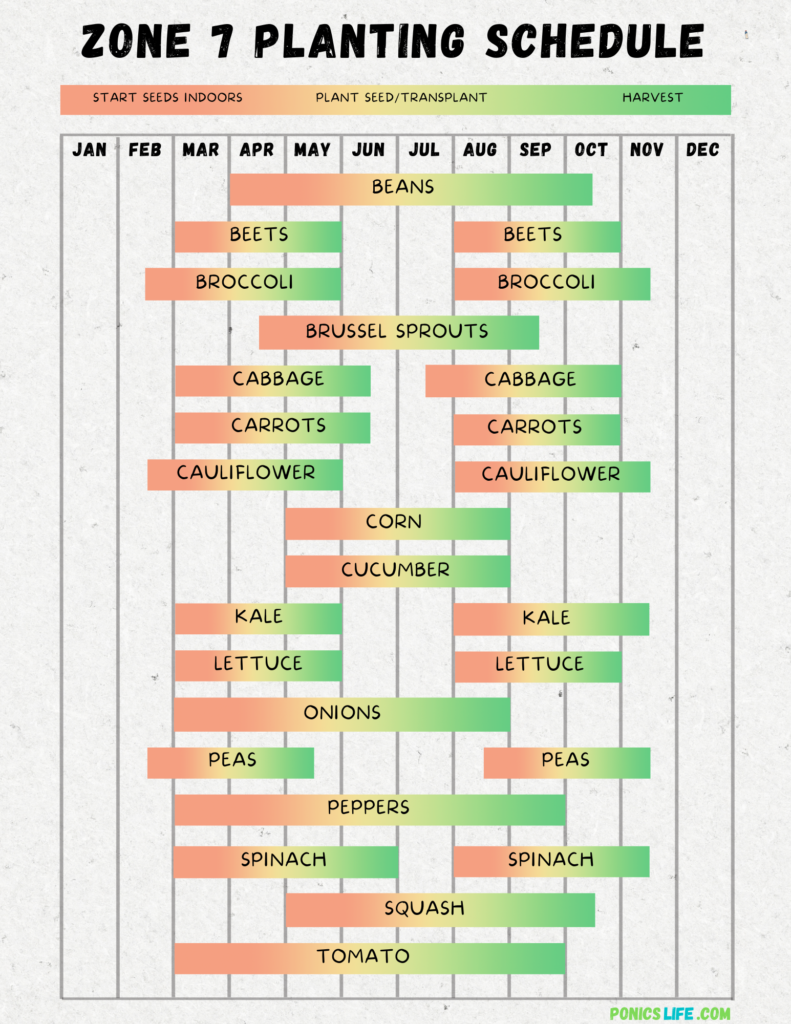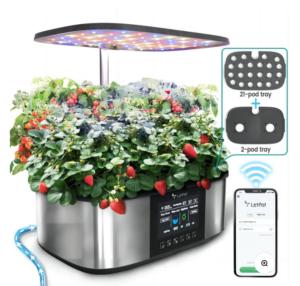Zone 7
“Zone 7 Planting Schedule and Calendar: A Quick Guide” offers a comprehensive look into the gardening calendar specific to Zone 7, a region in the US characterized by its longer growing season and varied microclimates.
This guide is crafted to clarify the optimal timing and methods for successful planting in this zone, where a blend of mild winters and hot summers opens up a diverse array of gardening opportunities.
From selecting the right plants to understanding the optimal times for sowing and harvesting, this quick, introductory guide and calendar is a must-read for anyone looking to maximize their gardening success in Zone 7, ensuring a vibrant, productive garden throughout the year.

Zone 7 Planting Schedule and Calendar
Below is a Zone 7 Planting Schedule/Calendar. Use it to effectively plan your gardening activities throughout the year, ensuring that your plants are sown, transplanted, and harvested at the optimal times for their growth and productivity. This schedule will help you maximize the yield and health of your garden by aligning your gardening practices with the specific climate conditions of zone 7.

Important Note: When looking at the schedule, don’t feel that you need to be exact. Just try to stay in the general ballpark of when your vegetables are supposed to be started, transplanted, and harvested. Although this is a rough outline, it’s designed to be flexible and adaptable to your unique gardening situation, taking into account variations in local weather patterns and individual plant needs. Remember, gardening is as much an art as it is a science, so use this schedule as a guide, not a strict rulebook.
Zone 7 Facts
- Zone 7 is designated by the USDA Plant Hardiness Zone Map, a tool that categorizes regions based on their average annual extreme minimum winter temperature. This system is crucial for gardeners and growers to identify the most suitable plants for their area’s climate.
- The Map uses color-coded zones, each representing a range of winter temperature averages to simplify the process of selecting appropriate plants for a region’s specific climate conditions.
- Zone 7 is characterized by average annual minimum winter temperatures ranging from 0 to 10 degrees Fahrenheit (-17.8 to -12.2 degrees Celsius). This range results in a milder climate compared to Zone 6, which supports a wider variety of plants including many popular perennials, annuals, vegetables, and shrubs. The zone typically experiences mild winters and warm summers, offering a unique gardening calendar throughout the year.
- Like other zones on the USDA Plant Hardiness Zone Map, Zone 7 is also subdivided into two half zones: 7a and 7b. These sub-zones represent a more detailed temperature gradient, with each half zone differing by about 5 degrees Fahrenheit. This distinction is crucial for more precise gardening and planting strategies, as 7a and 7b indicate slightly different average minimum winter temperatures. This caters to the needs of plants that require specific conditions for optimal growth.
- Zone 7a falls within (0 to 5 °F/-17.8 to -15 °C) and Zone 7b falls within (5 to 10 °F/-15 to -12.2 °C).
Why has Zone 7 Changed in the New USDA Hardiness Map?
The latest update to the USDA Plant Hardiness Zone Map reflects significant changes, showcasing a more detailed and accurate representation of growing climates across the United States. This new map, developed using advanced climate data collection and analysis techniques, offers a more nuanced understanding of the regional climates, particularly in terms of winter temperature averages.
One of the most notable changes in the new map is the shifting of certain areas into warmer hardiness zones. This change is a result of increased precision in temperature data and possibly reflects broader climate trends. For example, some regions previously classified in cooler zones may now find themselves in a higher zone number, indicating a warmer average minimum temperature. This shift is crucial for gardeners and agricultural planners, as it affects the selection of plants that are likely to thrive in these slightly warmer conditions.
Zone 7 FAQs
Explore our comprehensive FAQs below for valuable insights and practical tips on making the most of your garden in Zone 7.
Is the Zone 7 planting schedule relevant to outdoor hydroponic systems?
Yes, the Zone 7 planting schedule is relevant to outdoor hydroponic systems, particularly when these systems are exposed to the natural climate conditions of the zone. While hydroponics provides greater control over the growing environment, outdoor systems are still influenced by the milder seasonal temperature variations and frost dates typical of Zone 7. Adhering to the Zone 7 schedule can help hydroponic gardeners determine the best times for planting and harvesting, ensuring that plants are grown during optimal outdoor climate conditions. Indoor hydroponic systems, however, are less affected by external climate, allowing for more flexibility in planting schedules.
When is the best time to start planting in Zone 7
In Zone 7, the planting season generally starts earlier than in Zone 6. Gardeners can begin planting cool-season crops as early as March, and warm-season crops can be planted after the last frost date, which is typically earlier in Zone 7, often in early to mid-April. Again, local weather conditions should be monitored as frost dates can vary.
What vegetables thrive in Zone 7
Zone 7 supports a wide variety of vegetables. Cool-season crops like lettuce, spinach, and peas do well when planted early. Additionally, due to the longer growing season, warm-season crops such as tomatoes, peppers, eggplants, and cucumbers thrive when planted after the last frost date. Gardeners in Zone 7 can also grow certain crops that may not be as successful in cooler zones.
Is fall gardening possible in Zone 7?
Fall gardening in Zone 7 is quite advantageous. The mild winters allow gardeners to plant a second round of cool-season crops in late summer or early fall for a late harvest. Some crops might even survive the winter and produce a spring crop.
How should I prepare my garden for winter in Zone 7?
Preparing your garden for winter in Zone 7 might not be as intensive as in Zone 5 or 6 due to milder temperatures. However, it still involves cleaning up plant debris, protecting sensitive plants with mulch, and possibly planting cover crops. Adding compost to enrich the soil for the next growing season is also beneficial.
What is the USDA Hardiness Zone Map?
The USDA Hardiness Zone Map is a tool developed by the United States Department of Agriculture to categorize regions based on their average annual minimum winter temperature. It’s a valuable resource for gardeners and growers to select plants suited to their local climate.
Where can I find the full USDA Map?
If you’d like to explore the map itself, you can find it here. If you need information on how to use the map, you can find that here.
How is Zone 7 defined on this map?
Zone 7 is defined by average annual minimum winter temperatures ranging from 0 to 10 degrees Fahrenheit (-17.8 to -12.2 degrees Celsius). This milder climate allows for an extended variety of plants to be grown.
What are the sub-zones in Zone 7?
Zone 7 is divided into two sub-zones: 7a and 7b. 7a experiences winter temperatures from 0 to 5 degrees Fahrenheit (-17.8 to -15 degrees Celsius), while 7b ranges from 5 to 10 degrees Fahrenheit (-15 to -12.2 degrees Celsius).
What changes does the new USDA Hardiness Map show for Zone 7?
The updated USDA Hardiness Map may reflect shifts in the boundaries of Zone 7, indicating changes in average minimum winter temperatures. This can affect which areas are classified as Zone 7, potentially altering the planting strategies and plant selection for those areas.
How should gardeners in Zone 7 use the Hardiness Map?
Gardeners in Zone 7 should use the Hardiness Map to select plants that are appropriate for the winter temperatures of their specific area. The map also helps in planning the timing of planting and understanding the potential effects of local microclimates on gardening.
How do microclimates not represented on the USDA Hardiness Zone Map affect gardening, particularly in Zone 7?
Microclimates within Zone 7 can differ from the general climate indicated on the USDA Hardiness Zone Map. Factors such as urban heat islands, bodies of water, or unique landscape features can create localized climates. For instance, an urban area in Zone 7 might have a warmer microclimate, allowing for a broader selection of plants, while a shaded area might have cooler temperatures, influencing the growing season. Gardeners should observe and understand these microclimates as they might require adjustments in planting times and plant choices beyond what the broader map suggests.
How many Zones are in the US?
The United States has 13 zones across the United States and its territories: Zone 1, Zone 2, Zone 3, Zone 4, Zone 5, Zone 6, Zone 7, Zone 8, Zone 9, Zone 10, Zone 11, Zone 12, Zone 13.






